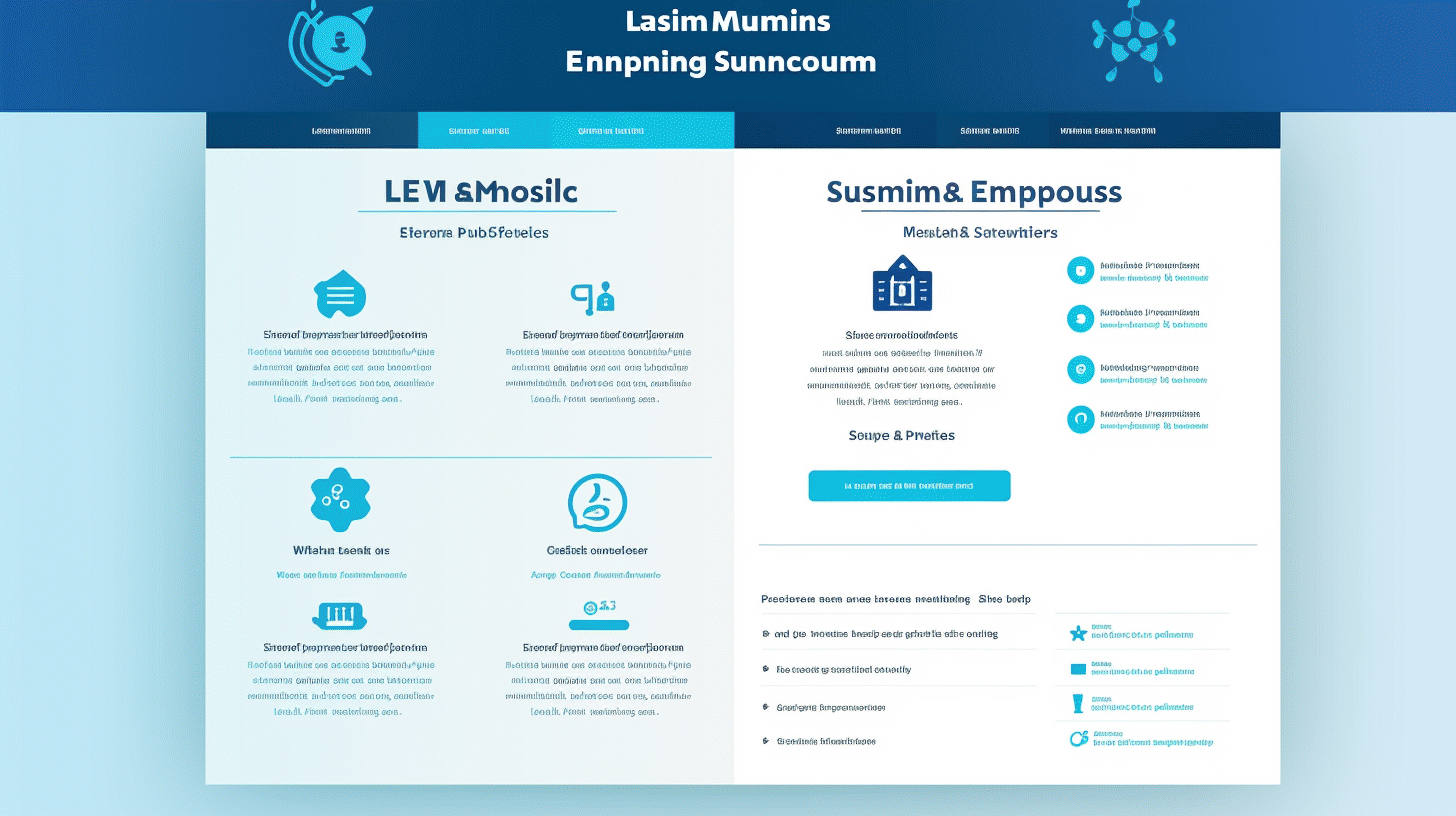在線上可見性和數位行銷領域中,搜尋引擎優化 (SEO) 發揮著至關重要的作用。結合有效的 SEO 策略可以幫助小型企業提高其線上形象、增加網站流量並最終推動成長。
在建立和優化網站方面,WordPress 是小型企業的熱門選擇。 WordPress 具有用戶友好的介面、可自訂的主題和豐富的外掛選項,為實施 SEO 實踐提供了堅實的基礎。
在本文中,我們將探討針對小型企業的 WordPress SEO 基礎知識,提供有價值的見解和實用技巧,幫助您最大限度地提高網站的知名度和影響力。我們將討論優化網站內容、行動和本地 SEO、增強頁面 SEO、利用社交媒體等主題。
因此,無論您是 WordPress 新手還是希望提升現有網站的效能,讓我們深入了解 WordPress SEO 的世界,並探索可以採取哪些步驟來提高您的線上形象。
繫好安全帶,準備釋放 WordPress SEO 促進小型企業發展的潛力。 🚀🌱
使用 WordPress 建立 SEO 友善網站
您是否知道實施 SEO 最佳實踐對於小型企業提高知名度和吸引自然流量至關重要?如果您使用 WordPress 來建立您的網站,那麼您已經走在正確的道路上了! WordPress 提供了一系列強大的工具和插件,可優化您的網站以適應搜尋引擎並提高您的排名。
優化網站內容
說到 SEO,創建高品質、富含關鍵字的內容是關鍵。以下是優化網站內容的一些策略:
- 關鍵字研究: 首先確定目標受眾可能搜尋的相關關鍵字或短語。使用 Google Keyword Planner 或 SEMrush 等工具來發現與您的行業相關的熱門搜尋字詞。
- 頁面優化: 有了關鍵字後,請策略性地將它們放置在您的網站內容中。這包括您的頁面標題、標題、正文、元描述和圖像的 alt 標籤。但是,請務必自然地使用關鍵字並避免關鍵字填充,因為這會對你的排名產生負面影響。
- 內容結構: 將您的內容組織成易於掃描的部分,並配有清晰的標題和副標題。這不僅可以幫助用戶瀏覽您的網站,還可以幫助搜尋引擎了解您的內容的結構和相關性。
- 內部連結: 在您的內容中加入內部鏈接,以引導用戶訪問您網站上的相關頁面或部落格文章。這有助於搜尋引擎更有效地發現和索引您的內容並改善整體用戶體驗。
請記住,創建有價值且資訊豐富的內容並引起觀眾的共鳴應該始終是首要關注點。良好的 SEO 實踐應該補充和增強您的內容,而不是掩蓋它。
網站外的操作
雖然優化您的網站內容至關重要,但您也可以採取網站以外的措施來改善您的 SEO。以下是一些可以考慮的策略:
- 反向連結: 從信譽良好的網站建立高品質的反向連結是提升網站權威性和提高搜尋引擎排名的有效方法。聯繫業界有影響力的人,參與客座部落格機會,或與其他企業合作以獲得有價值的反向連結。
- 社群媒體參與: 在社群媒體平台上與受眾互動不僅有助於提高品牌知名度,還可以產生可以對您的 SEO 產生積極影響的社交訊號。鼓勵社交分享您的內容,回覆評論和訊息,並積極參與相關討論。
- 網站速度和效能: 快速加載的網站不僅可以提高用戶體驗,而且在搜尋引擎排名中也起著至關重要的作用。透過使用快取外掛程式、壓縮映像和最小化 HTTP 請求來優化您的網站速度。
- 移動優化: 由於大多數網路使用者透過行動裝置造訪網站,因此針對行動用戶優化您的網站至關重要。選擇適合行動裝置的 WordPress 主題,使用 Google 的行動裝置友善性測試測試您的網站的行動裝置友善性,並優化您的網站以便在行動裝置上快速載入。
透過實施這些策略,您可以使用 WordPress 建立一個 SEO 友善的網站,並增加在搜尋引擎結果中排名更高的機會。請記住隨時了解最新的 SEO 趨勢和演算法,以確保長期成功。
現在您已經了解了 SEO 對於您的 WordPress 網站的重要性,讓我們來探索一些可以幫助您進一步優化網站的頂級 SEO 外掛程式。 請參閱我們關於頂級 SEO 插件的指南 2022 年的 WordPress 必用插件,可協助您增強 SEO 工作。 🚀
結合關鍵字策略實現更好的SEO
介紹:
在當今的數位環境中,擁有一個優化良好的網站對於希望提高其線上知名度和吸引自然流量的企業來說至關重要。提高網站搜尋引擎排名的最有效策略之一是關鍵字優化。透過策略性地將相關關鍵字納入您的內容中,您可以幫助搜尋引擎了解您的網站內容並在搜尋結果中排名更高。
利用長尾關鍵字:
在關鍵字優化方面,許多企業僅注重使用搜尋量大的廣泛、通用的關鍵字。雖然定位這些關鍵字至關重要,但將長尾關鍵字納入你的 SEO 策略也同樣重要。
什麼是長尾關鍵字?這些是網路使用者在搜尋特定產品、服務或主題時使用的更長、更具體的短語。將長尾關鍵字納入你的內容可以帶來以下幾個好處:
- 競爭較少: 與通用關鍵字相比,長尾關鍵字的搜尋量通常較低。然而,它們的競爭也較少,這使得您的網站更容易在搜尋結果中排名更高並吸引目標流量。
- 更好的使用者意圖定位: 長尾關鍵字往往反映使用者的特定需求和意圖。透過使用這些關鍵字,您可以確保您的內容與用戶正在主動搜尋的內容相符,從而提高將他們轉化為客戶的機會。
- 更高的轉換率: 由於長尾關鍵字更具體,它們可以吸引更接近購買點或尋求特定資訊的用戶。透過定位這些用戶,您可以增加將他們轉化為有價值的潛在客戶或客戶的可能性。
以下範例說明了通用關鍵字和長尾關鍵字之間的差異:
- 通用關鍵字:“鞋子”
- 長尾關鍵字:“扁平足女式跑鞋”
透過定位長尾關鍵字,您不僅更有可能吸引專門尋找扁平足跑鞋的用戶,而且還有更高的機會為他們提供他們所需的確切資訊或產品。
結論:
將長尾關鍵字納入您的 SEO 策略可以顯著提高您網站的知名度和自然流量。透過針對特定的用戶需求並相應地優化您的內容,您可以增加在搜尋結果中排名更高、吸引目標流量並將其轉化為有價值的潛在客戶或客戶的機會。
針對行動和本地 SEO 進行最佳化
在當今的數位環境中,擁有一個行動友善的網站並結合本地搜尋引擎優化策略對於希望吸引和吸引目標受眾的企業來說至關重要。隨著智慧型手機的興起和語音搜尋的日益普及,針對行動和本地 SEO 進行優化變得比以往任何時候都更加重要。
📱創建適合行動裝置的網站
當涉及到行動搜尋引擎優化時,第一步就是確保您的網站適合行動裝置。以下是需要考慮的一些關鍵因素:
- 響應式設計:確保您的網站採用響應式設計,這意味著它會自動調整其佈局和內容以適應不同的螢幕尺寸。這可確保使用者無論透過桌上型電腦、平板電腦或智慧型手機造訪您的網站,都能獲得無縫的瀏覽體驗。
- 行動頁面速度:行動用戶在等待網站載入時通常缺乏耐心。針對行動裝置優化網站的頁面速度至關重要。壓縮圖像、縮小程式碼並最小化伺服器回應時間以確保快速載入時間。
- 適合行動裝置的內容:根據行動用戶的需求客製化內容,使其簡潔、結構良好且易於在小螢幕上閱讀。使用標題、項目符號和較短的段落來增強可讀性。
🌍 Google 存取權限的重要性
Google 的演算法將行動友善視為排名因素,這意味著未針對行動裝置進行最佳化的網站在搜尋引擎結果頁面 (SERP) 上的排名可能不會太好。谷歌重點關注行動領域的原因如下:
- 行動優先索引:Google現在主要使用網站的行動版本進行索引和排名。如果您的網站不適合行動設備,它可能不會出現在行動搜尋結果中,從而導致大量潛在流量的損失。
- 使用者體驗:Google 優先提供最佳的使用者體驗,而行動友善網站有助於實現這一目標。透過針對行動裝置優化您的網站,您可以為行動用戶提供流暢、直覺的體驗,增加他們留在您的網站、與您的內容互動並最終轉化為客戶的機會。
📍 融入本地 SEO 策略
除了行動優化之外,實施本地 SEO 策略還可以大大使依賴本地客戶的企業受益。以下是增強本地搜尋引擎優化效果的幾個關鍵方法:
- Google 我的商家:聲明並優化您的「Google 我的商家」資料。確保您的商家資訊準確,包括您的地址、電話號碼和營業時間。鼓勵客戶留下評論,因為積極的評論可以提高您當地的排名。
- 本地關鍵字:將本地關鍵字納入您的網站副本、元標籤和標題中。這有助於搜尋引擎了解您的業務的地理相關性,並增加出現在本地搜尋結果中的可能性。
- 引文和線上目錄:在特定於您的行業和位置的線上目錄和引用網站中列出。這些平台上一致的 NAP(姓名、地址、電話號碼)資訊可以提高您本地的 SEO 排名。
透過針對行動裝置優化您的網站並結合本地搜尋引擎優化策略,您可以提高您的線上知名度,覆蓋更廣泛的受眾,並最終為您的企業帶來更多的流量和客戶。掌握行動和本地搜尋引擎優化的最新趨勢和技術,確保您的網站在數位領域保持競爭力。
增強小型企業網站的頁面搜尋引擎優化 (SEO)
在當今的數位環境中,擁有強大的線上影響力對於小型企業的成功至關重要。促成這一成功的關鍵因素之一是優化頁面 SEO。透過實施有效的頁面 SEO 策略,小型企業網站可以提高其在搜尋引擎結果中的可見性,推動自然流量,並最終產生更多的潛在客戶和轉換。在本文中,我們將探討三種基本的頁面 SEO 技術,這些技術可以幫助小型企業提升網站的表現並實現其數位行銷目標。
引人注目的元描述
當談到頁面搜尋引擎優化時,元描述在吸引搜尋引擎用戶點擊方面發揮著重要作用。元描述是搜尋引擎結果頁面(SERP)中頁面標題下方顯示的簡短摘要。它提供了網頁內容的簡潔概述,並幫助用戶決定是否點擊連結。若要優化小型企業網站的元描述,請考慮以下提示:
- 保持簡潔且引人注目: 盡量寫出長度約為 150-160 個字元的元描述。使用有說服力的語言來吸引用戶點擊您的連結。
- 包括相關關鍵字: 在您的元描述中自然地加入相關關鍵字,向搜尋引擎表明您的網頁內容。
- 突顯獨特賣點: 使用元描述來突出顯示您的企業提供的獨特優勢或價值主張,以在競爭中脫穎而出。
透過製作引人注目的元描述,準確反映您的網頁內容並吸引搜尋引擎用戶,您可以增加吸引點擊和為小型企業網站帶來流量的可能性。
選擇 SEO 友善的主題
您的網站的設計和結構對於優化頁面 SEO 起著至關重要的作用。為您的小型企業網站選擇主題或範本時,選擇 SEO 友善的選項至關重要。搜尋引擎優化 (SEO) 友善的主題將幫助您的網站在搜尋引擎結果中獲得更好的排名並提供更好的用戶體驗。選擇主題時請考慮以下因素:
- 移動響應能力: 確保主題適合行動裝置且反應迅速,因為行動優化是搜尋引擎的關鍵排名因素。
- 載入速度快: 選擇輕量級且針對快速載入速度進行最佳化的主題。網站載入緩慢會對使用者體驗和 SEO 排名產生負面影響。
- 結構化資料標記: 尋找支援結構化資料標記的主題,這有助於搜尋引擎以更有意義的方式理解和顯示您的內容。
選擇 SEO 友善的主題可以為您的小型企業網站的頁面 SEO 工作奠定堅實的基礎,並確保為您的訪客提供積極的用戶體驗。
優化永久連結結構
永久連結結構是指您的網頁的 URL 結構。優化您的永久連結結構可以顯著影響您網站的 SEO 效能。請遵循以下針對小型企業網站的最佳做法:
- 保持簡單: 使用簡潔、描述性的 URL,讓搜尋引擎和使用者都易於理解。避免使用長串數字或不相關的字元。
- 納入關鍵字: 在您的永久連結中包含相關關鍵字,以便向搜尋引擎提供有關您網頁主題的更多背景資訊。
- 使用連字符代替底線: 使用連字符(而不是底線)分隔 URL 中的單字。這有助於搜尋引擎區分單字並提高可讀性。
透過優化您的永久連結結構,您可以建立清晰、富含關鍵字的 URL,讓搜尋引擎和使用者更容易瀏覽和了解您網站的內容。
總之,增強頁面 SEO 是小型企業建立強大線上形象的基本面向。透過專注於引人注目的元描述、選擇 SEO 友好的主題以及優化永久連結結構,小型企業主可以提高其網站在搜尋引擎結果中的可見性,並提高吸引自然流量的機會。實施這些策略來改善您網站的頁面 SEO,並將您的小型企業在數位世界中推向新的高度。
改善網站架構和內部鏈接
優化網站結構和導航
當談到提高您的網站在搜尋引擎結果頁面上的排名時,需要考慮的一個重要方面是網站的結構和導航。一個組織良好、用戶友好的網站結構不僅可以提供更好的用戶體驗,還可以幫助搜尋引擎更有效地理解和索引您的內容。在本節中,我們將探討一些技巧和最佳實踐,以優化您的網站結構和導航,從而改善 SEO。
網站架構的重要性
擁有清晰、合理的網站結構對於用戶和搜尋引擎都至關重要。原因如下:
- 使用者體驗: 結構良好的網站可以讓使用者更輕鬆地瀏覽並找到所需的資訊。透過將內容組織成類別和子類別,您可以建立使用者友善的瀏覽體驗,讓訪客保持參與度並鼓勵他們探索您網站上的更多頁面。
- 搜尋引擎爬蟲: 搜尋引擎爬蟲使用內部連結來發現和索引您的網頁。優化的網站結構具有清晰的層次結構,可以使搜尋引擎更輕鬆地抓取並理解內容的相關性和上下文。
優化網站架構的技巧
現在我們了解了網站結構的重要性,讓我們來看看一些優化網站的實用技巧:
- 邏輯層次: 透過將內容組織成類別和子類別來建立邏輯層次結構。這有助於搜尋引擎和用戶更有效地瀏覽您的網站。避免創建包含太多頂級頁面的淺層網站結構,因為這可能會導致混亂並使搜尋引擎更難理解您的內容的相關性。
- URL 架構: 使用描述性且富含關鍵字的 URL,準確反映您的網頁內容。避免使用不提供任何上下文的通用或神秘的 URL。例如,
www.example.com/page1.html, 使用www.example.com/blog/on-page-seo-tips.html讓使用者和搜尋引擎清楚地了解該頁面的主題。 - 導航菜單: 設計一個直覺且易於使用的導航選單,讓使用者可以輕鬆存取您網站的不同部分。在主選單中包含重要頁面,並使用下拉式選單顯示子類別。不要忘記添加網站地圖和搜尋框以進一步增強用戶導航。
- 麵包屑: 實作麵包屑導覽來向使用者顯示到達特定頁面所採取的路徑。麵包屑不僅可以改善使用者導航,還可以幫助搜尋引擎了解您網站的結構和不同頁面之間的關係。
- 內部連結: 內部連結是網站結構優化的一個重要面向。建立內容時,請確保包含指向您網站上其他頁面的相關內部連結。這不僅可以幫助使用者發現相關內容,還可以幫助搜尋引擎了解網頁的互聯性。
結論
優化網站架構和導航是提高 SEO 效能和使用者體驗的關鍵一步。透過遵循上面概述的提示和最佳實踐,您可以創建一個組織良好、既用戶友好又對搜尋引擎友好的網站。請記住,清晰、合乎邏輯的網站結構不僅可以幫助用戶更有效地瀏覽您的網站,還可以幫助搜尋引擎更有效地發現和索引您的內容。因此,花點時間評估和改進您的網站結構——您的 SEO 努力將會感謝您!
利用社群媒體和線上目錄進行 SEO
在當今的數位環境中,擁有強大的線上影響力對於企業的成功至關重要。提高知名度和改善搜尋引擎優化(SEO)的一種方法是利用社交媒體平台和線上目錄。這些平台讓您能夠與目標受眾建立聯繫,提高您的品牌知名度,並增加您網站的自然流量。讓我們探索如何有效地使用社群媒體和線上目錄來增強您的 SEO 策略。
📢 利用社群媒體建立線上形象
Facebook、Instagram、Twitter 和 LinkedIn 等社群媒體平台提供了與受眾建立聯繫並展示您的品牌的獨特機會。以下是如何利用社群媒體獲得 SEO 優勢的方法:
- 創造引人入勝的內容: 製作引人入勝的貼文、圖片和視頻,引起目標受眾的共鳴。使用相關的關鍵字和標籤來提高您在社群媒體和搜尋引擎上的知名度。
- 分享您的網站內容: 透過定期在您的社群媒體資料上分享您的部落格貼文、文章和其他有價值的內容來增加您網站的流量。這可以提高您的網站的知名度並增強您的 SEO 效果。
- 與觀眾互動: 及時回覆評論、訊息和提及。與受眾建立有意義的聯繫可以促進社交分享,並有可能提高您的搜尋引擎排名。
- 鼓勵社交分享: 在您的網站內容中添加社交分享按鈕,以便訪客輕鬆地在他們的社交媒體資料上分享您的內容。這可以擴大您的影響力、提高參與度並為您的網站產生有價值的反向連結。
📝 使用 Google 商業檔案註冊
Google Business Profile(以前稱為 Google My Business)是一款功能強大的工具,可讓企業管理其在 Google 上的線上形象。它不僅可以幫助您出現在相關的本地搜尋結果中,還可以增強您的整體 SEO 效果。以下是如何利用 Google 商業檔案獲得 SEO 優勢的方法:
- 認領並驗證您的個人資料: 首先聲明您的 Google 商家資料,並確保您商家的所有資訊(例如姓名、地址、電話號碼和網站)都是準確且最新的。
- 優化您的個人資料: 添加引人注目的業務描述,選擇相關類別,並上傳高品質圖像,使您的個人資料具有視覺吸引力。
- 收集並回覆評論: 鼓勵滿意的客戶在您的 Google 商家資料上留下正面的評價。回覆評論(無論是正面的還是負面的)表明您重視客戶回饋並可以提升您的線上聲譽。
- 利用 Google Posts: 利用 Google Posts 功能分享有關您的業務、特別優惠、新聞和活動的最新動態。這有助於提高您在 Google 搜尋引擎結果頁面 (SERP) 上的知名度並吸引更多客戶造訪您的網站。
透過有效利用社群媒體平台和線上目錄,您可以擴大您的線上影響力,建立品牌權威並提高您的搜尋引擎排名。請記住定期監控和評估您的社交媒體和目錄性能,以做出必要的調整並最大化您的 SEO 效果。
那麼,為什麼要等待呢?立即開始將社群媒體和線上目錄整合到您的 SEO 策略中,見證它們對您企業的線上可見性和成功的重大影響!
關鍵字研究與競爭對手分析
當談到為搜尋引擎優化您的網站時,關鍵字研究和競爭對手分析是兩個至關重要的步驟,它們可以發揮很大的作用。透過了解目標受眾使用的關鍵字並分析競爭對手的策略,您可以獲得寶貴的見解並在數位遊戲中保持領先一步。
關鍵字研究的重要性
關鍵字研究是任何成功的 SEO 策略的支柱。透過確定正確的關鍵字,您可以優化網站內容,以在搜尋引擎結果頁面(SERP)中獲得更高的排名並吸引相關的自然流量。這就是為什麼關鍵字研究至關重要:
- 了解使用者意圖: 透過研究關鍵字,您可以深入了解目標受眾正在搜尋的內容及其潛在意圖。這些知識使您能夠自訂您的內容以滿足他們的需求,從而增加吸引合格潛在客戶的機會。
- 發現利基機會: 關鍵字研究可以幫助您發掘產業中尚未開發的市場空間。透過識別長尾關鍵字和特定的搜尋查詢,您可以瞄準利基市場並進入競爭較少的利潤豐厚的細分市場。
- 提高內容相關性: 透過將相關關鍵字納入您的內容,搜尋引擎可以更好地理解您的網頁的主題和意圖。這會增加您獲得更高排名並出現在合適的受眾面前的機會。
- 優化語音搜尋: 隨著 Siri 和 Alexa 等語音助理的興起,優化語音搜尋變得越來越重要。關鍵字研究可協助您辨識與語音搜尋查詢相符的對話關鍵字和長尾關鍵字。
分析競爭對手
競爭對手分析是有效 SEO 策略的另一個關鍵面向。透過研究競爭對手的行為,您可以發現差距、發現機會並微調自己的方法。這就是為什麼分析競爭對手至關重要:
- 辨識競爭對手的關鍵字: 透過分析競爭對手的網站和內容,您可以深入了解他們所針對的關鍵字。這些資訊可以幫助您發現在初步研究中可能錯過的高效能關鍵字。
- 了解內容差距: 透過研究競爭對手的內容,您可以發現他們可能缺乏的領域或沒有完全滿足目標受眾需求的領域。這些知識使您能夠創建填補這些空白並提供附加價值的內容。
- 監控反向連結設定檔: 反向連結在 SEO 中起著至關重要的作用,競爭對手分析可以幫助您識別連結到競爭對手的網站。透過分析他們的反向連結配置文件,您可以為自己的網站找到潛在的連結建立機會。
- 保持領先趨勢: 透過關注競爭對手,您可以了解最新的行業趨勢、搜尋引擎演算法的變化和新興策略。這些知識使您能夠相應地適應和調整您的 SEO 工作。
總之,關鍵字研究和競爭對手分析是製定強大的 SEO 策略的重要步驟。透過了解目標受眾使用的關鍵字並分析競爭對手的策略,您可以有效地優化您的網站並在 SERP 中保持領先一步。請記住,SEO 是一個持續的過程,持續的研究和分析對於保持您的競爭優勢至關重要。
要了解有關 SERP 排名的更多資訊以及如何實現排名, 點這裡.
更新內容和重新利用部落格文章
在快節奏的數位行銷世界中,保持內容的新鮮和最新至關重要。它不僅可以幫助您保持強大的線上影響力,而且還確保您為受眾提供價值。作為內容創作者,您可能會發現自己面臨著不斷為部落格文章和文章提出新想法的挑戰。然而,有一種更有效的方法來進行內容創作——更新和重新利用現有的部落格文章。
更新並重新利用部落格文章
- 利用常青內容的力量:常青內容是指無論何時創建,都是永恆的、與受眾相關的內容。透過定期更新這些帖子,您可以繼續吸引流量並吸引讀者。
- 刷新過時的信息:花點時間檢查您的部落格文章,找出任何過時的資訊或統計數據。使用準確和最新的資訊更新內容以保持其相關性和可信度。
- 新增新的見解和觀點:隨著時間的推移,您可能會獲得新的經驗或對某個特定主題獲得新的觀點。利用這些見解為您現有的部落格文章增加價值。為您的讀者提供他們可能覺得有趣和有用的最新觀點。
- 針對 SEO 進行優化:隨著搜尋引擎演算法的發展,您的內容也應隨之發展。花點時間使用相關的關鍵字、元標籤和標題來優化您的部落格文章,以確保在搜尋引擎結果中獲得更好的可見性。
- 建立新格式:重新利用部落格文章不僅限於簡單地更新文字。考慮將您的內容轉換為不同的格式,例如影片、播客或資訊圖表。這使你能夠接觸到更廣泛的受眾,並提供另一種獲取資訊的方式。
- 透過不同管道進行推廣:當您更新和重新利用您的部落格文章時,請確保透過各種管道推廣它們。在社交媒體上分享它們,將它們包含在您的電子郵件簡報中,並考慮聯繫其他網站或有影響力的人來分享您的更新內容。
更新和重新利用您的部落格文章是最大化現有內容價值的明智策略。它可以節省您的時間和精力,同時仍讓您的網站保持新鮮並吸引您的受眾。因此,請花一點時間來檢查您的部落格檔案並重新發現可以透過一點 TLC 恢復活力的隱藏寶石。您的讀者將會欣賞最新的訊息,而您將獲得網站流量和參與度增加的好處。
監控效能和技術 SEO
當談到為搜尋引擎優化您的網站時,監控效能和實施技術 SEO 最佳實踐至關重要。在本節中,我們將探討一些需要關注的關鍵領域,以確保您的網站順利運作並在搜尋引擎結果中獲得良好的排名。
監控核心網路指標
核心網路生命力已成為決定網站整體使用者體驗的重要因素。這些指標主要關注載入速度、互動性和視覺穩定性。透過監控和優化這些關鍵績效指標,您可以增強使用者體驗並提高您的網站在搜尋結果中的可見度。
以下是一些需要關注的核心網路重要指標:
- 最大內容塗料 (LCP):此指標衡量頁面上最大內容的載入時間。目標是使 LCP 達到 2.5 秒或更快。
- 首次輸入延遲 (FID):FID 衡量使用者在初始載入後與您的網站互動所需的時間。將 FID 保持在 100 毫秒以下以獲得流暢的使用者體驗。
- 累積佈局偏移 (CLS):CLS 衡量您的網頁的視覺穩定性。它關注可能令用戶感到沮喪的意外佈局變化。目標是使 CLS 分數低於 0.1。
使用 Google 的 PageSpeed Insights 或 Google Search Console 中的核心網路生命力報告等工具定期監控這些指標,可以幫助您確定需要改進的領域並提高網站的整體效能。
確保網站安全
網站安全不僅對於保護用戶資料至關重要,而且對於維護網站的聲譽和搜尋引擎排名也至關重要。搜尋引擎優先考慮安全的網站,因此實施強大的安全措施應該是首要任務。
以下是確保您的網站安全的一些關鍵步驟:
- 保持軟體更新:定期更新您的內容管理系統 (CMS)、主題和外掛程式以修補漏洞。
- 使用信譽良好的託管服務提供者:選擇提供內建安全功能和 SSL 憑證以進行加密連線的託管服務提供者。
- 安裝安全插件:利用 Wordfence 或 Sucuri 等安全性外掛程式來監控您的網站並保護其免受惡意軟體和駭客攻擊。
- 實施強密碼:所有使用者帳號均使用複雜密碼,並定期更新。
透過遵循這些安全實踐,您可以減輕潛在風險並保護您的網站及其訪客免受各種線上威脅。
關注搜尋意圖
理解並使您的內容與用戶搜尋意圖保持一致對於提高您的網站在搜尋結果中的可見性至關重要。搜尋意圖是指用戶查詢背後的原因,分為四類:
- 訊息意圖:尋找資訊或問題答案的使用者。
- 導航意圖:尋找特定網站或網頁的使用者。
- 交易意向:希望執行特定操作(例如購買或下載資源)的使用者。
- 商業意圖:使用者在做出購買決定之前希望研究和比較產品或服務。
優化您的內容以符合目標受眾的搜尋意圖,有助於搜尋引擎了解您網站的相關性,並提高在搜尋結果中排名更高的機會。
實施技術 SEO 最佳實踐
技術 SEO 專注於優化您網站的技術方面,以提高其在搜尋引擎中的可爬行性、可索引性和整體效能。
以下是一些需要實施的技術 SEO 最佳實踐:
- 優化您的網站結構:確保您的網站結構合理、條理清晰且導航清晰。
- 優化頁面標題和元描述:為每個頁面編寫獨特、描述性且富含關鍵字的標題和元描述。
- 針對行動裝置優化您的網站:由於大多數網路使用者都在行動裝置上瀏覽,因此擁有一個能夠提供無縫使用者體驗的行動友善網站至關重要。
- 提高頁面載入速度:優化圖片、縮小程式碼並利用快取技術來提高網站的載入速度。
- 實作架構標記:Schema 標記可協助搜尋引擎了解您內容的上下文,並可提高您的網站在搜尋結果中的可見度。
透過實施這些技術 SEO 最佳實踐,您可以確保搜尋引擎能夠有效地抓取和理解您的網站,從而提高排名和知名度。
請記住,在優化和監控網站的效能和技術 SEO 時,必須跟上行業趨勢和演算法更新,以保持競爭優勢並維持最佳用戶體驗。因此,使用託管 WP 保護您的 WordPress 網站 有用的提示和技巧 並釋放您網站的全部潛力!
結論
總之,對於希望推動自然流量、提高知名度和擴大線上影響力的小型企業來說,實施有效的 WordPress SEO 策略至關重要。透過優化網站內容、結合關鍵字策略和增強頁面搜尋引擎優化 (SEO),企業可以提高其搜尋引擎排名並吸引更多潛在客戶。
此外,專注於行動和本地 SEO、改進網站結構和內部連結、利用社交媒體和線上目錄、進行徹底的關鍵字研究和競爭對手分析都是成功的 SEO 策略的重要組成部分。
定期更新和重新發布部落格文章、監控網站效能和實施技術 SEO 最佳實踐對於在競爭激烈的線上環境中保持領先地位也至關重要。
請記住,SEO 是一個持續的過程,需要持續的努力和適應性。透過在 WordPress SEO 上投入時間和資源,小型企業可以有效地與更大的競爭對手競爭並實現長期成長和成功。
為了簡化這些策略的實施並確保無縫的 WordPress 體驗,請考慮使用 Managed-WP™,這是一個高級託管 WordPress 雲端託管平台。 Managed-WP™ 簡化了您網站的基礎架構,提供自由的數位體驗,並提供專家全天候的問題解決方案。立即開始使用 Managed-WP™ 來充分發揮您的 WordPress 網站的潛力。
了解有關 Managed-WP™ 的更多信息 並將您的線上形象提升到新的高度。
常見問題解答
- 為什麼 WordPress SEO 對小型企業很重要?
WordPress SEO 對於小型企業非常重要,因為它有助於提高線上可見度、增加自然流量、吸引潛在客戶並最終推動業務成長。
- WordPress 網站的一些基本 SEO 實踐有哪些?
WordPress 網站的一些基本 SEO 實踐包括優化頁面標題和元描述、使用相關關鍵字、創建高品質內容、優化圖像、確保快速的載入速度以及建立高品質的反向連結。
- 有沒有適用於 WordPress 的免費 SEO 外掛?
是的,WordPress 有幾個免費的 SEO 外掛程式可用。一些流行的包括 Yoast SEO、All in One SEO Pack 和 Rank Math,它們提供一系列功能來改善您網站的 SEO。
- 我需要編碼技能來實施 WordPress SEO 策略嗎?
不,您不需要編碼技能來實施 WordPress SEO 策略。 Yoast SEO 等 SEO 外掛程式提供了用戶友好的介面,讓您無需任何程式設計知識即可輕鬆優化網站的 SEO。
- 要多久才能看到 WordPress SEO 的效果?
從 WordPress SEO 工作中看到結果所需的時間可能因各種因素而異,例如您所在行業的競爭力、您的內容品質以及您的 SEO 策略的有效性。一般來說,可能需要幾週或幾個月才能看到搜尋引擎排名和自然流量的顯著改善。



















